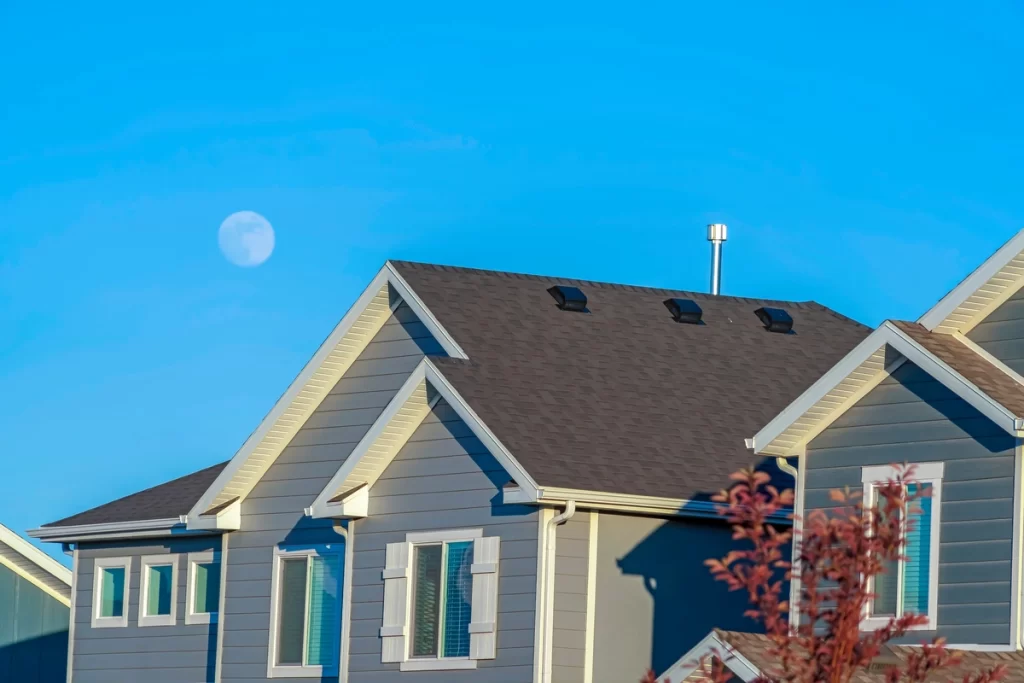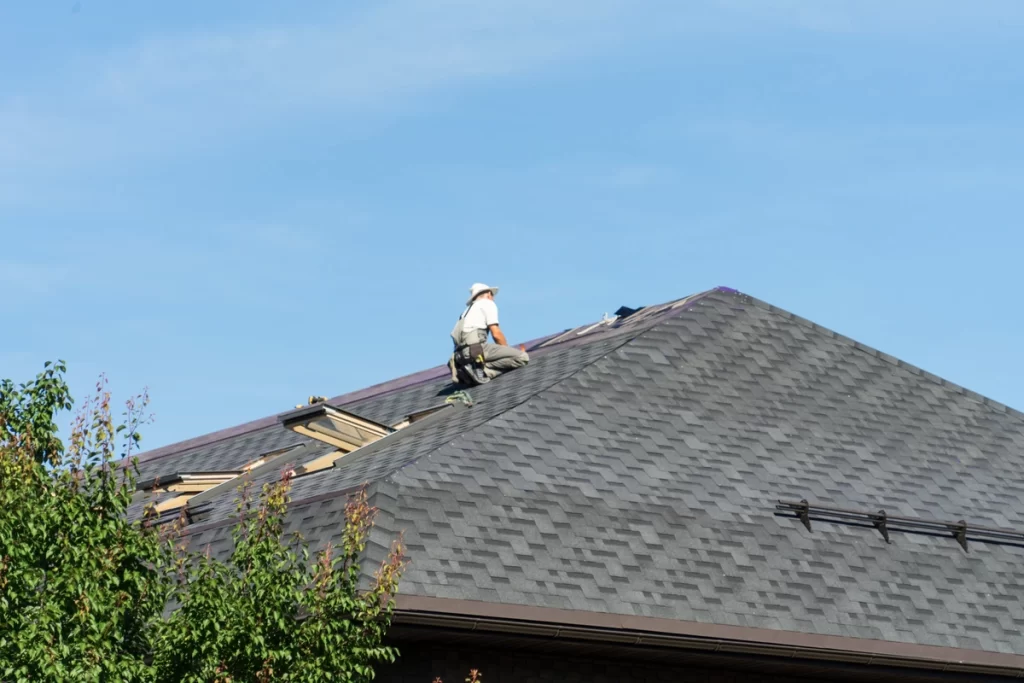Even though we see it every day, much of how your roof works remains a mystery to the average homeowner. One of those things? How to calculate roof pitch.
Whether you’re planning to install a new roof, make repairs, or just satisfy your curiosity, understanding your roof’s pitch is crucial. In this guide, we’ll cover everything you need to know about calculating roof pitch, from what you might need to know your roof pitch to when to call a professional and the cost of a roof replacement.
6 Tools You Might Need to Know Your Roof Pitch
Before you start calculating your roof pitch, it’s essential to gather some basic information and tools. Here’s what you might need:
1. A Helper 🙋🏽
While you can calculate roof pitch on your own, having a helper can make the process easier and safer. They can assist in measuring and holding the necessary tools while you take the measurements.
2. Ladder and Safety Gear 🪜
Working on a roof can be hazardous, so ensure you have a sturdy ladder and appropriate safety gear, such as a harness and non-slip footwear.
3. Tape Measure 📏
A tape measure is essential for measuring the run and rise of your roof. Make sure it’s long enough to reach the highest point of your roof.
4. Level ⚖️
A level, preferably a long one, will help ensure your measurements are accurate. You’ll use it to establish a horizontal line.
5. Pencil and Paper 📝
Keep a pencil and paper handy to jot down measurements and perform calculations.
6. Calculator or Smartphone 📱
You’ll need a calculator or smartphone to perform some simple math calculations, which we’ll explain shortly.
How to Calculate Roof Pitch

Calculating roof pitch is relatively straightforward, and there are several methods to do it. Here, we’ll cover two common methods: the “2-Step Method” and the “12-Inch Method.”
Method 1: The 2-Step Method
- Measure the Run: Climb onto your roof safely and measure the horizontal distance (run) from the edge of the roof to the highest point. Use your tape measure to get this measurement in feet.
- Measure the Rise: Starting from the same point where you measured the run, measure the vertical distance (rise) from the roof’s highest point down to the same horizontal line. Again, use your tape measure to get this measurement in feet.
- Calculate the Pitch: To calculate the pitch, divide the rise by the run. For example, if your rise is 6 feet, and the run is 12 feet, your roof pitch would be 6/12, which simplifies to 1/2 or 0.5. Your roof pitch is 0.5:12.
Method 2: The 12-Inch Method
- Measure a 12-Inch Section: Instead of measuring the entire run and rise, this method simplifies the process by measuring a 12-inch horizontal and vertical section of your roof.
- Count the Rise: Using your level, measure a 12-inch horizontal section on your roof. Next, measure the vertical distance from the edge of the 12-inch section to the highest point. This measurement represents the rise in inches.
- Calculate the Pitch: The pitch is expressed as the ratio of the rise in inches to 12 inches. For example, if the rise is 6 inches in a 12-inch section, the pitch is 6:12, which simplifies to 1:2 or 0.5.
Remember that these methods provide the same pitch value, whether you use feet or inches for the measurements. Both methods give you a clear understanding of your roof’s pitch.
When to Call a Professional
While calculating roof pitch can be a DIY project, there are circumstances when it’s advisable to call a professional roofer or structural engineer:
- Complex Roof Structures: If your roof has multiple angles, dormers, or intricate designs, determining the pitch accurately can be challenging. In such cases, a professional can provide precise measurements and recommendations.
- Safety Concerns: Roof work can be dangerous, especially if you lack experience or proper safety equipment. If you have any doubts about your ability to safely measure your roof’s pitch, it’s better to leave it to the experts.
- Roof Repairs or Replacement: When planning roof repairs or replacement, professional roofers will calculate the pitch as part of their assessment. They have the expertise to ensure your new roof is properly designed and installed to meet local building codes.
- Structural Concerns: If you suspect structural issues with your roof, such as sagging or compromised framing, it’s crucial to involve a structural engineer. They can assess the roof’s condition, calculate the pitch, and recommend necessary repairs.
The Cost of a Roof Replacement

Understanding your roof’s pitch is just one step in the process of roof maintenance or replacement. When it comes to a roof replacement, the cost can vary significantly based on various factors:
1. Roof Size and Pitch
The size and pitch of your roof play a significant role in determining the cost. Steeper roofs are more challenging to work on and may require additional safety precautions, increasing labor costs.
2. Roofing Material
The type of roofing material you choose will impact the overall cost. Common options include asphalt shingles, metal roofing, clay tiles, and more. Each material has its price range, with some being more expensive than others.
3. Labor Costs
Labor costs vary by location and can be influenced by factors such as the local labor market, demand for roofing services, and the complexity of the job.
4. Removal of Old Roofing
If you’re replacing an existing roof, you’ll need to consider the cost of removing the old roofing material, which can add to the overall project cost.
5. Additional Features
Additional features like skylights, chimneys, or ventilation systems can increase the complexity of the roofing project and add to the cost.
6. Roofing Warranty
Some roofing materials come with warranties that can affect the overall cost. Longer warranties may come with higher upfront costs but provide peace of mind in the long run.
7. Local Building Codes and Permits
Depending on your location, you may need to obtain permits and comply with local building codes. These requirements can add to the project cost.
To get an accurate estimate for your roof replacement, it’s recommended to consult with several roofing contractors. They can assess your specific situation, including the pitch of your roof, and provide you with detailed quotes.
Determine Roof Pitch Like a Pro
Understanding your roof’s pitch is a fundamental step in roof maintenance and replacement. With the right tools and methods, you can calculate your roof pitch yourself, but when in doubt or faced with complex situations, it’s best to consult with professionals.
And when you want a professional roofing contractor that you can trust, you want Monarch Roofing! Contact us today to get started.





